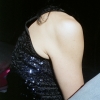Taking portraits and looking at the other was always a way for José Pedro Cortes to think about the reality that surrounds us. As a creator of images, he accepts the complexity of this time, its fabrication and its impulses, its vulnerability and beauty, which do not allow for dogmatic readings.
In contrast with neoliberal realism, his images affirm the necessity of not allowing ourselves to be subordinated to pragmatic vision of life, because reality is not mechanic, linear or numerical, but a challenge that demands daily attention and reflection. In these rooms, we come across men and women who look at us, others who sensually caress each other in bed, and we observe a group of
friends languidly relaxing on a lawn, on a summer’s afternoon.
There aren’t any geographies or time scales, and, as observers of José Pedro Cortes’ photographs, we are voluntarily invited to make fast, slow, intense movements, which go in and out, running through the centres and along the margins, attempting to find life, but also the skeleton, ruin and remains
that time leaves in its wake.
Crespo (researcher and art critic) and a previously unpublished poem titled Music for images by José Pedro Cortes by José Tolentino de Mendonça (poet and theologian).









